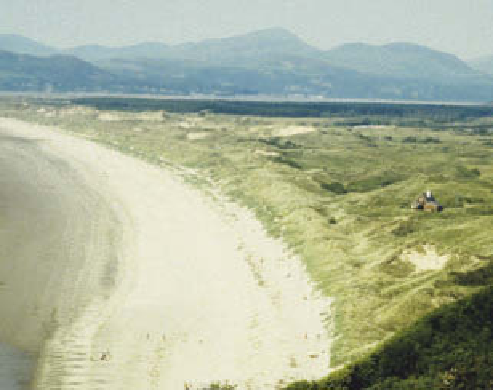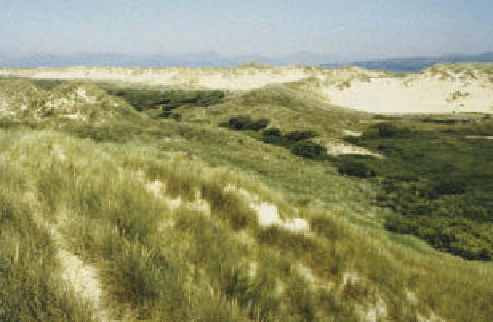Geoscience Reference
In-Depth Information
right) and an associated sand bar block Pennard Pill, Gwr
coast, south Wales, creating a salt-marsh lagoon.
Photo: Ken Addison
coast of Wales, viewed from the fore-dunes (foreground)
across a dune slack (centre) to partially blown-out hind-dunes
(background).
Photo: Ken Addison
Wales, which now isolates Harlech Castle (1 km inland, out of
view) and formed subsequent to the castle's construction
after
AD
1282.
Photo: Ken Addison
incapable of matching sand aggradation rates. However,
plant communities tolerant of the harsh aeolian
environment form distinctive biogeomorphic dune
systems in suitable locations. Aeolian deposits are also
common in the geological record. Continental siliciclastic
sediments of Devonian (Welsh borderland, Scottish
midland valley) and Permo-Triassic (English Midland
basin) age show clear dune bedforms and mark Britain's
northward passage across the subtropical divergence belts
400-200 Ma ago. They are important sources of long-term
palaeoclimate and palaeocurrent information, and
modern ergs and loess sheets retain clear evidence of
Quaternary climatic change.
CONCLUSION
Wind is more dependent on the prior operation of other
geomorphic processes than any other agent and is,
ironically, not dominant in Earth's storm belts. Aridity
enhances wind power and the absence of vegetation is a
decisive factor in determining the distribution of aeolian
landsystems. Wind lacks extensive rock-quarrying power,
and its erosive impact is confined largely to the scouring
and ornamentation of bedrock surfaces. Dune bed forms
reflect the interactive effects of air flow and landforms
on each other. Accelerated deflation is one agent of
desertification, removing topsoil and burying vegetation













































